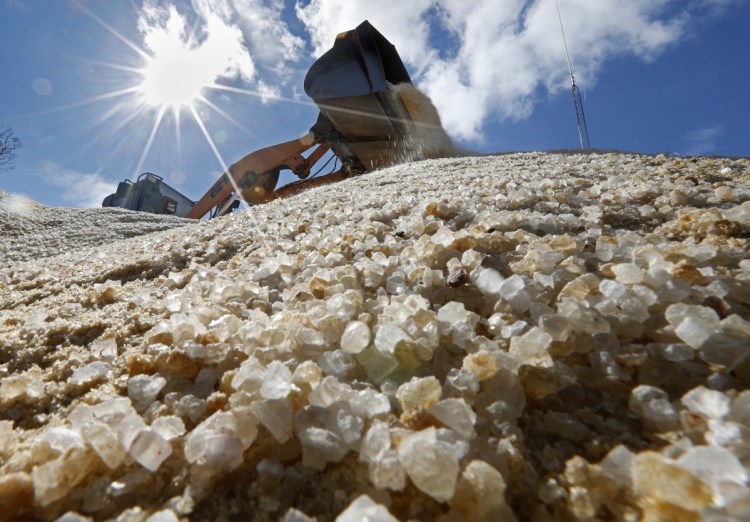Beginning with a couple of early snowstorms before Thanksgiving, it seems like more rock salt has been dumped on southern Maine roads this season than snow. (Looking ahead at this weekend’s forecast as I write this, though, that may be about to change.)
At least a few times I’ve driven out of our wet-but-not-icy driveway in mid-morning to find that road crews had dumped heavy bands of rock salt along the highways – probably because roads were icy closer to dawn when people with real jobs head off to work. It is a matter of public safety, and I can appreciate that. I also know that road salt is a caustic and corrosive mineral that can eat away at the metal of motor vehicles.
More pertinent here, lawns and other plants also suffer damage when hit by the salt that plows push off streets along with the fallen snow and high-flying slush.
“Road salt always has the potential to damage when there isn’t enough moisture to dilute the salt when plants break dormancy in the spring,” said Frank Wertheim, an educator with the York County office of the University of Maine Cooperative Extension.
If we get heavy spring rains, the salt will dissolve and wash away, and its impact will be minimal. But if the salt remains in the soil, it will feel to plants just like a drought. To understand why, you have to know how plants pull water in from the soil: Plant roots contain salts, which attract water to the plant.
“Anyone who has tried to get table salt out of a wet shaker knows how readily salt absorbs water,” Leonard Perry, an Extension education with the University of Vermont said in an article for Green Mountain Gardener. “Rock salt exhibits the same property in the soil and absorbs much of the water that would normally be available to roots.”
The action on gardens from road salt is similar to what happens when gardeners accidentally use too much fertilizer – because fertilizers are mostly made up of salts, although in different chemical combinations from the sodium chloride of road and table salt. Gardeners often call the damage “fertilizer burn.”
“It creates an instantaneous drought,” Wertheim said, with the salts pulling moisture out of roots.
One measure people can take come spring is to pull out a hose and soak the areas where plows dumped salty snow all winter long – effectively washing the problem away, Wertheim said.

Ice cleats or grips on your shoes make it safe to walk on ice.
A University of Massachusetts publication outlines the damage done to the above-ground areas of plants.
“Salt spray can cause salt burn on buds, leaves and small twigs. Salt spray can also cause damage by desiccating the bud scales, exposing tender tissues of the developing leaves and flowers,” the article said. “Many times, the damage is not evident until late winter or spring.”
While you can’t do much about state or municipal trucks dumping salt on the edge of your property, you can control what goes on your own driveway and walks.
First, use as little salt as possible. Many publications advise putting down salt before the storm hits, but I don’t do that. I want safe driveways and walkways, but they don’t have to be totally free of snow and ice.
Never put salt on top of deep snow. First remove the snow – whether by shovel, snowblower or plow. If the temperature is going to rise into the 40s after the storm, any remaining snow will melt anyway, so don’t use anything.
I use a mix of sand and salt only when there is a coating of ice – which is highly slippery. If what is left on the driveway and walkways is packed or crusty snow, I use nothing – unless we are expecting company – because it is not dangerously slippery. I don’t put down anything within 3 feet of the edge of the driveway.
So far this season, I have used just one garden trowel of salt-sand mix from the 5-gallon pail that I picked up from our town’s pile in early November. The area by the back door was glare ice, but the rest of the driveway had crusty snow pellets and they weren’t that slick.
Another solution for avoiding salt is to let the ice remain and put cleats or grips on your shoes. They make it safe to walk even on the slickest ice.
Salt to melt ice isn’t the only problem. After the remnants of Hurricane Irma sent storm surges onto cropland, a report from two Cornell University professors noted that the damage from the rough weather was about the same as from road salt. And the damage is more severe if the soil is high in clay.
If you are designing a roadside garden, putting the garden on a slant or creating small gullies (known in Maine as roadside ditches) so the water can flow away from the plants will help reduce the amount of salt damage. And for people installing a new ornamental garden that will be subject to salt, use plants that tolerate it. The GardenPro Answer Book, which sells for $30 on the University of Maine Extension website, includes a long list of plants that are salt tolerant, Wertheim said, including horse chestnuts, serviceberry, hawthorn, lilacs, oaks, staghorn sumac, bayberries, beach plum, Siberian iris and day lilies.
The catalog for O’Donal’s Nursery in Gorham also includes such a list, and gardening professionals at your favorite nursery will help you.
But right now I suggest you start by using less salt – and getting your hose out in early spring.
Tom Atwell is a freelance writer gardening in Cape Elizabeth. He can be contacted at:
tomatwell@me.com
Send questions/comments to the editors.


